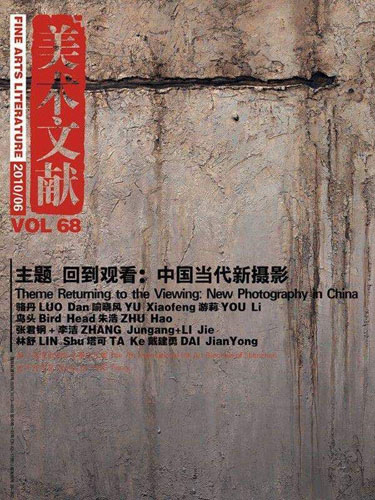第68期 回到观看:中国当代新摄影(2010年)
学术主持:鲍栋
主题:骆丹 喻晓风 游莉 鸟头 朱浩 张君钢+李洁 林舒 塔可 戴建勇
新作:应天齐 田卫 赵燕峰 曾扬 崔如琢 邵仄炯
Issue No. 68(2010)
Theme: Return to the Viewing: New Photography in China
Academic Host: Bao Dong
A.T: Luo Dan, Yu Xiaofeng, You Li, Niaotou, Zhu Hao, Zhang Jungang+Li Jie, Lin Shu, Ta Ke, Dai Jianyong
A.N: Ying Tianqi, Tian Wei, Zhao Yanfeng, Zeng Yang, Cui Ruzhuo
回到观看:中国当代新摄影
学术主持:鲍栋
摄影可以用来在媒体上讨论公共话题,也可以用来在相册中塑造个人记忆;摄影经常被用来证明某物或某事的客观性,但摄影有时也被用来抒情、想象与虚构……关于摄影,其实已经有很多种用法,也将会有无数可能的功用。如其他文化实践活动一样,摄影也是一种社会化的活动,作为视觉活动的摄影始终处在视觉的各种话语及制度中,正是这些话语与制度带来了摄影的不同用法以及我们关于摄影的各种看法。于是,摄影越来越被理解为一种表征(即再现)的工具,我们越来越多地把摄影与种族、性别、阶层,与历史、现实,与社会及政治,与理论及文本联系起来。但观看本身却越来越被忽视了。
实际上,不管是出现在何种用法和观念中,摄影首先是一种观看活动,摄影的价值基础也取决于观看本身。观看何以有本身,因为观看并不像人们不加反思地认为的那样——是在反映某个纯粹的真实,我们所见的真实已经被观看所影响、修改,甚至决定,以至于观看本身已经替代了那种形而上的“真实”而成为我们直接面对的东西。因此,摄影与其说记录了现实,还不如说是记录了观看,对于拍摄者来说,现实与观看是统一的,世界总是取景框或LCD屏中的世界,“真实”也只有出现在了照片上才成为了现实。
当然,并不是所有的观看都是有价值的,大部分时候,人们总是在重复着他人的角度,在用他人的镜头来观看,于是,我们见到的大部分照片都索然无味,甚至令人厌烦,尤其是它们还在标榜自身的政治正确性与美学标准性的时候。实际上,我们之所以需要并寄希望于摄影,是因为摄影能够并应该带来一种创造性的观看,摄影的最重要的任务就是让我们日渐疲乏的双眼再次振奋起来。
可观看并不是一件容易的事情,尤其是在这个所谓的“图像的时代”,当图像越来越多,也就越来越廉价,当观看显得毫不费力,那是因为人们的眼睛已经被驯服了,他们的“观看”只是在识别一些简单但安全的美学及意义,换句话说,他们只是在看那些“好看”、“好懂”的东西。观看,或者说摄影的难度就在于如何从那些“好看”、“好懂”以及各种各样的视觉话语编码中摆脱出来,即如何解放观看?
答案是易见的:把摄影还原为观看,也即是把世界还原为表象,把世界从各种意义的牢笼中还原出来,通过悬置它的确实性而返还它的自在性。自在是自由的前提,而正是自由允诺给了我们自觉观看的可能,在这种自由的允诺下,每一次具体的拍摄都应该是一次观看的自觉创造,都应该提供给我们能够从那些视觉话语及制度中挣脱出来的跳板。而观众的任务则是去重新观看,使观看再次出场,直到观看永远在场,换话句话说,摄影的意义在于让我们能够保持观看的自觉,并投入在这种观看的自觉之中。回到观看,就是返回到摄影之为艺术的起点。
Return to the Viewing: New Photography in China
Academic Host: BAO Dong
Photography can be either used to discuss public issues in media or create personal memories in albums; more often than not it is used to prove the objectivity of something while sometimes serving as a tool for the expression of emotions, imagination and fiction… Photography has already been used in a great many ways and it will provide countless potential functions. Just like other cultural practices, photography is also a socialized activity. As a visual activity, it is forever bound in all kinds of languages and systems of the vision, which bring the multitude of functions for photography and a variety of opinions we have on photography. Therefore, photography tends to be increasingly interpreted as a tool of representation while we associate photography more and more with race, sex and class, history, reality and society as well as politics, theory and text. But the viewing itself has been gradually cast into neglect.
In fact, no matter how it’s used and where it’s used, photography is first and foremost a viewing activity, with its foundation of value also depending on the viewing itself. Unlike our thoughtless presumption, the viewing is not a reflection of some pure reality, and the reality that we perceive has already been influenced, edited and even decided by the viewing, so much so that the viewing itself has already replaced the metaphysical “reality” and become what we face directly. Therefore, photography is a record of the viewing rather than the reality. As for photographers, the reality and the viewing are unified as one – the world only exists in the finder frame or LCD screen and the reality won’t come true until it’s presented in pictures.
Of course, not all the viewing is of value. In most cases, people keep repeating others’ angles and seeing through others’ lenses, resulting in insipid even obnoxious photos, especially when they flaunt their political correctness and aesthetic standard. Actually, the reason we need and put our hope in photography is that it could and should bring a creative viewing, and the most significant task of photography is to refresh our exhausted eyes.
But viewing is not an easy job, especially during this so-called “image era”. While piling up in heaps, images become more and more cheap, and the reason that the viewing becomes effortless is because people’s eyes are already tamed, their viewing is just the identification of some simple but safe aesthetics and meanings, in other words, they are just viewing those “pretty” and “easy” things. The difficulty of viewing or photography is how to break free from those “pretty” and “easy” things as well as all kinds of codes of visual languages, namely how to liberate the viewing?
The answer is plain and simple: restore photography to the viewing, namely the restoration of the world to presentation, releasing the world from the cage of all kinds of meanings and restoring its unrestrainedness through the suspension of its validity. The unrestrainedness serves as the premise of the freedom, which in turn promises us the possibility of spontaneous viewing, under such promise of freedom, each specific shooting should be a spontaneous creation of viewing, providing us with a springboard to break free from the visual languages and systems. Whereas the task of the audience is to view afresh, inviting the viewing back onto the stage until it stays on forever. In other words, the meaning of photography is for us to keep the spontaneity of the viewing and commit ourselves to it. Return to the viewing means going back to the starting point of photography as an art.

